The convergence of automated deployment and cloud computing has fundamentally transformed how video content is processed, delivered, and managed in the digital age. As demand for high-quality video streaming surges across industries-from entertainment and education to enterprise communications-organizations are increasingly turning to automated workflows and cloud infrastructure to meet scalability, efficiency, and reliability requirements. This article explores the technical foundations, practical applications, and future trends of automated deployment in cloud-based video processing systems.

The Rise of Automated Deployment in Video Workflows
Automated deployment refers to the use of scripts, tools, and pipelines to streamline the setup, configuration, and maintenance of software systems. In video processing, this translates to:
- CI/CD Pipelines: Tools like Jenkins, GitLab CI, and GitHub Actions automate testing and deployment of video encoding/transcoding software.
- Infrastructure-as-Code (IaC): Terraform and AWS CloudFormation enable reproducible cloud environments for video rendering farms.
- Containerization: Docker and Kubernetes ensure consistent runtime environments for video AI models and analytics tools.
For example, a streaming platform can automatically deploy updated video compression algorithms across 10,000 cloud instances within minutes, eliminating manual configuration errors.
Cloud-Native Video Processing Architectures
Modern cloud platforms (AWS Elemental, Azure Media Services, Google Cloud Transcoder) provide specialized services for:
- Real-time transcoding: Adaptive bitrate streaming for diverse devices
- AI-powered enhancements: Automated upscaling, noise reduction, and object detection
- Distributed rendering: Parallel processing of 4K/8K video frames
A case study from Netflix reveals how their cloud-based "Meson" system handles 1.5 million concurrent video streams daily using automated scaling policies and regional deployment strategies.
Technical Challenges and Solutions
- Latency Optimization: Edge computing integration reduces processing delays (e.g., AWS Wavelength for 5G video streaming).
- Cost Management: Spot instances and serverless architectures (AWS Lambda) cut cloud expenses by 40-60%.
- Security: Automated certificate rotation and DRM systems protect video assets.
Tools like FFmpeg combined with cloud GPU instances (NVIDIA T4 on GCP) demonstrate how a 2-hour 4K video can be processed in 8 minutes at $0.15 per job.
Future Trends
Emerging technologies are pushing boundaries further:
- Serverless Media Processing: Event-driven architectures for user-generated content platforms
- MLOps for Video: Automated training/deployment of custom video AI models
- Blockchain-Based Royalty Distribution: Smart contracts for automated payment splits in cloud video platforms
Industry analysts predict that 78% of video processing workloads will shift to automated cloud environments by 2027, driven by 5G rollout and metaverse applications.
Automated deployment in cloud video systems isn't merely a technical upgrade-it's a strategic imperative. By reducing manual intervention, accelerating time-to-market, and enabling elastic scalability, organizations can deliver superior video experiences while maintaining cost efficiency. As AI and edge computing mature, the fusion of automation and cloud-native architectures will continue redefining what's possible in video technology.









